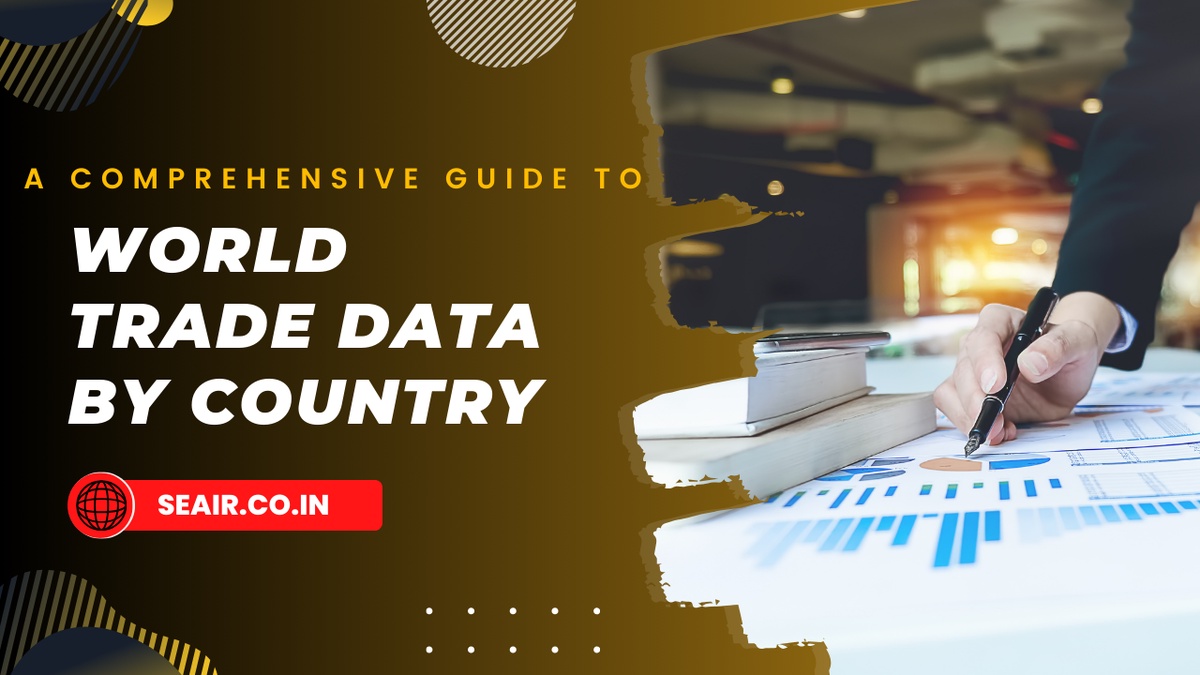World trade data encompasses statistical information on the exchange of goods and services between nations. It encompasses various variables, including product categories, trade values, quantities, trading partners, and chronological data.
Significance of Analyzing World Trade Data
World trade data is a crucial asset for businesses, policymakers, and researchers. It serves multiple purposes:
- Identifying new market potentials
- Assessing competitive landscapes
- Evaluating supply chain vulnerabilities
- Formulating effective trade policies
- Monitoring prevailing global trade trends
Purpose of the Guide
This guide aims to offer a comprehensive overview of world trade data, encompassing its definition, importance, sources, and applications. Additionally, it delves into the latest trends and advancements in global trade.
Understanding World Trade Data
A. What Constitutes World Trade Data?
World trade data typically encompasses:
- Product categorizations (e.g., Harmonized System (HS) codes)
- Trade values (e.g., denominated in US dollars)
- Quantities exchanged (e.g., in units or kilograms)
- Trade partners (e.g., countries or regions)
- Timeframes (e.g., monthly or yearly)
B. Sources of World Trade Data
World trade data is sourced from a variety of outlets, including:
- International organizations (e.g., World Trade Organization (WTO), United Nations Comtrade)
- Government agencies (e.g., US Census Bureau, European Commission)
- Industry reports (e.g., International Monetary Fund (IMF), World Bank)
- Private companies (Seair Exim Solutions, eximpedia, Exportimportdata )
Historical Perspective
A. Evolution of World Trade
Over the centuries, world trade has undergone significant evolution, from the ancient Silk Road to the modern era of intricate global supply chains. It has been instrumental in economic progress and cultural interchange.
B. Key Milestones in Global Trade History
Notable milestones include:
- The Age of Exploration (15th and 16th centuries): Pioneering explorers extended trade routes to the Americas, Asia, and Africa.
- The Industrial Revolution (18th and 19th centuries): Technological breakthroughs spurred a surge in global trade, particularly in manufactured goods.
- The Great Depression (1930s): Global trade plummeted, leading to protectionist measures and trade conflicts.
- The General Agreement on Tariffs and Trade (GATT) (1947): GATT established a multilateral framework for reducing tariffs and trade barriers.
- The World Trade Organization (WTO) (1995): Succeeding GATT, the WTO broadened its scope to encompass services and intellectual property.
C. Impact of Historical Events on Trade Patterns
Historical events have wielded considerable influence on global trade patterns. Wars, pandemics, and economic upheavals have disrupted trade flows. Yet, trade has also served as a unifying force, connecting diverse societies worldwide.
The Top Players in World Trade
A. Leading Exporting Countries
The foremost exporting nations are:
- China
- United States
- Germany
- Japan
- South Korea
B. Leading Importing Countries
The top importing nations are:
- United States
- China
- Germany
- Japan
- United Kingdom
C. Major Trade Blocs and Alliances
Prominent trade blocs and alliances encompass:
- North American Free Trade Agreement (NAFTA)
- European Union (EU)
- Comprehensive and Progressive Agreement for Trans-Pacific Partnership (CPTPP)
- Association of Southeast Asian Nations (ASEAN)
- Regional Comprehensive Economic Partnership (RCEP)
Analyzing Export Data
A. Categories of Exported Goods and Services
Exported goods fall into several categories, including agricultural products, manufactured goods, mining products, and services.
B. Trends in Export Volumes Over the Years
Global export volumes have experienced consistent growth, with exceptions during major economic crises such as the Great Depression and the 2008 financial crisis.
C. Export Partnerships and Alliances
Collaborative export efforts, particularly within trade blocs, foster enhanced trade flows by reducing tariffs and other trade impediments.
Import Data Demystified
A. Categories of Imported Goods and Services
Imported goods mirror export categories, with specific preferences shaped by a nation's needs and resources.
B. Trends in Import Volumes Over the Years
Global import volumes have mirrored export trends, underlining the reciprocal nature of trade.
C. Key Importing Partnerships and Alliances
Trade blocs play a pivotal role in enhancing import volumes by reducing tariffs and trade barriers among member countries.
Trade Balance: Surpluses and Deficits
A. Understanding Trade Balance
A nation's trade balance is the disparity between its exports and imports. A surplus arises when exports surpass imports, while a deficit occurs when imports outstrip exports.
B. Countries with Surplus
Leading nations with trade surpluses include:
- China
- Germany
- Japan
- South Korea
- Saudi Arabia
C. Countries with Deficit
Top nations with trade deficits comprise:
- United States
- India
- United Kingdom
- France
- Netherlands
Factors Influencing Global Trade Patterns
A. Economic Factors
Economic variables, including exchange rates and economic policies, wield substantial influence over global trade patterns. For instance, a weaker currency can heighten a country's export competitiveness internationally.
B. Political Factors
Political considerations such as trade agreements and geopolitical tensions also exert a significant impact on global trade patterns. Trade agreements mitigate tariffs and other trade barriers, while geopolitical tensions can disrupt trade flows.
Emerging Markets and Their Impact
A. Definition of Emerging Markets
Emerging markets are economies experiencing rapid growth and development, often characterized by lower per capita incomes, yet boasting a burgeoning middle class and escalating consumer spending.
B. Noteworthy Emerging Market Economies
Some notable emerging market economies encompass:
- China
- India
- Brazil
- Mexico
- Indonesia
C. Influence on Global Trade Dynamics
Emerging markets play an increasingly pivotal role in global trade as significant exporters and importers. Their rise has also led to the formation of new trade partnerships and alliances.
Case Studies: Successful Trade Models
A. Singapore: A Trade Hub Success Story
Singapore stands as a prime exemplar of a nation that has flourished through trade. Its strategic location at the crossroads of major shipping routes, coupled with policies like low tariffs and a free trade zone, have propelled it into a major trade hub.
B. Germany's Export-Led Growth Model
Germany serves as another instance of a nation that has achieved economic prosperity through trade. A leading exporter of manufactured goods, particularly machinery and vehicles, Germany's export-driven model has catalyzed job creation and bolstered its economy.
C. China's Economic Ascendancy through Trade
China's economic ascent in recent decades has been chiefly propelled by trade. It has emerged as a substantial exporter of manufactured goods, including electronics and textiles. Additionally, China has reaped benefits from global investments.
Navigating World Trade Databases
A. Introduction to Trade Databases
A multitude of world trade databases, both public and private, are available. These databases furnish comprehensive data on trade flows, product categories, and trading partners.
B. How to Access and Interpret Data
Accessing and interpreting world trade data typically requires creating an account with the database provider. Subsequently, users can search for data using various criteria, such as product category, country, and date range. The database will then furnish a list of results, which can be viewed and downloaded.
C. Recommended Databases and Platforms
Some commendable world trade databases and platforms encompass:
- World Trade Organization (WTO) Trade Statistics
- United Nations Comtrade
- US Census Bureau Foreign Trade Statistics
- European Commission Trade Statistics
Using World Trade Data for Business Insights
Businesses can leverage world trade data to glean insights into markets, competitors, and supply chains. This information facilitates informed decisions regarding pricing, marketing, and sourcing.
A. Market Research and Entry Strategies
Trade data enables businesses to pinpoint new market potentials and devise entry strategies. For instance, businesses can identify countries with significant imports of a specific product and target them with tailored marketing efforts.
B. Supply Chain Optimization
Trade data is invaluable for optimizing supply chains. It aids in identifying reliable suppliers and reducing transportation costs, among other benefits.
C. Risk Assessment and Management
Trade data serves as a linchpin for assessing and mitigating risks. For instance, it can spotlight countries with a history of trade disputes or political instability, allowing businesses to navigate potential challenges more effectively.
Challenges and Limitations of World Trade Data
A. Data Accuracy and Reliability
Ensuring the accuracy and reliability of trade data is a paramount challenge. Data quality can vary based on the reporting country and the data source. Businesses should exercise caution and rigor in evaluating the data's quality before making decisions based on it.
B. Missing Data and Inconsistencies
Incomplete or inconsistent data poses another challenge. Certain countries may not report their trade data promptly or may employ different classification systems. Businesses must be cognizant of these limitations when utilizing trade data.
C. Addressing Data Privacy Concerns
Trade data may encompass sensitive information, such as importer and exporter details. Businesses must take measures to safeguard the privacy of this data when employing it.
Future Trends in Global Trade
A. Digitalization and E-commerce Impact
Digitalization and the burgeoning e-commerce sector are reshaping global trade. Businesses increasingly leverage online platforms to reach customers worldwide, ushering in new trade patterns and fostering the growth of digital trade platforms.
B. Sustainability and Green Trade Practices
Sustainability and environmentally-conscious trade practices are assuming heightened importance. Businesses face mounting pressure to reduce their environmental footprint and adopt sustainable practices, precipitating a shift towards greener products and services and the development of eco-friendly trade routes.
C. Predictions for the Future of World Trade
Despite challenges, global trade is anticipated to continue its growth trajectory. The ascendancy of emerging markets and the surge in digital trade are pivotal factors expected to propel this growth.
Conclusion:
World trade data stands as a vital resource for businesses and policymakers alike. By harnessing this data for insights into markets, competitors, and supply chains, businesses can make informed decisions crucial for growth and success. Policymakers, in turn, can leverage trade data to formulate policies that foster economic prosperity and international cooperation.


No comments yet